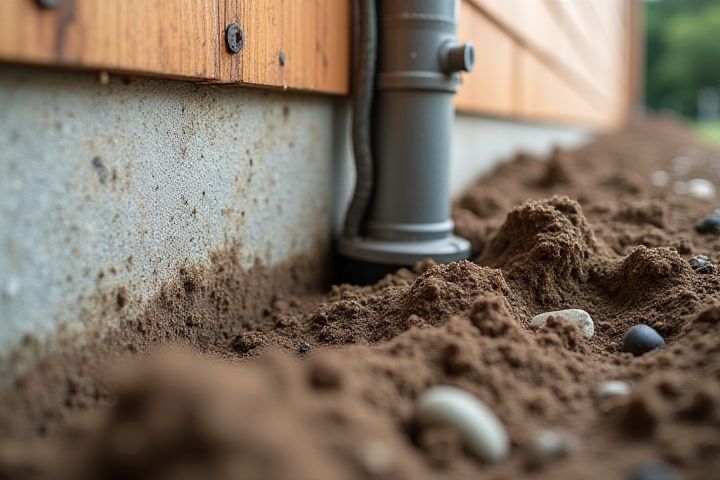
House foundation issues often arise from soil movement, which can be caused by factors such as excessive moisture, drought, or poor drainage. Expansive clay soils, when wet, can swell and push against the foundation, while dry conditions can lead to shrinkage, creating gaps. Other contributors include tree roots that absorb moisture from the soil, undermining structural stability. Improperly installed gutters can exacerbate water pooling near the foundation, leading to erosion or settling over time. Regular maintenance and monitoring of drainage systems can help mitigate these risks, ensuring your foundation remains solid and secure.
What Causes House Foundation Issues
Poor soil compaction
Poor soil compaction is a primary cause of house foundation issues, arising when the soil beneath a structure is not adequately compacted during construction. This can lead to uneven settling, creating voids that compromise the stability of the foundation. Over time, fluctuations in moisture content can exacerbate the problem, causing the soil to expand or contract, which further destabilizes the foundation. Ensuring proper compaction through thorough testing and grading is crucial for maintaining a solid foundation and preventing costly repairs.
Expansive clay soils
Expansive clay soils, which can expand and contract significantly with moisture changes, are primary contributors to house foundation issues. When these clay soils absorb water, they swell, exerting pressure on foundations and leading to cracks and structural instability. Conversely, during dry periods, the soil contracts, leaving voids that further destabilize the foundation. Homeowners should monitor moisture levels and consider implementing proper drainage solutions to mitigate the impacts of expansive clay on their properties.
Drainage problems
Poor drainage around your home's foundation can lead to significant structural issues. When rainwater or melting snow accumulates near the base of your house, it exerts hydrostatic pressure, which can cause soil expansion and contraction. This constant fluctuation can create cracks in the foundation and uneven settling, ultimately compromising its integrity. Regularly inspecting and maintaining gutters, downspouts, and grading can help mitigate these drainage problems and protect your home's foundation.
Plumbing leaks
Plumbing leaks can significantly contribute to house foundation issues by creating moisture accumulation around the foundation walls. When water seeps into the soil underneath or adjacent to your home, it destabilizes the ground, causing soil erosion and shifting. This shifting can lead to cracks in your foundation, misalignment of doors and windows, and other structural problems. Regular inspections of plumbing systems and prompt repairs are essential to mitigate these risks and protect your home's foundation integrity.
Tree root intrusion
Tree root intrusion significantly contributes to house foundation issues by exerting pressure and disrupting soil stability. As trees grow, their roots spread out and can penetrate foundations, causing cracks and structural damage. The moisture absorption by roots can also lead to soil shrinkage, which can exacerbate settling and misalignment of the foundation. Regular monitoring of nearby trees and proper landscaping can help mitigate these risks and protect your home's structural integrity.
Poor construction practices
Poor construction practices significantly contribute to house foundation issues. Inadequate soil preparation, such as failing to properly compact the ground, can lead to uneven settling and structural instability. Using substandard materials, like low-grade concrete or inadequate reinforcement, weakens the foundation's integrity. Moreover, neglecting proper drainage systems results in water accumulation, which further exacerbates soil erosion and foundation damage.
Flooding or water accumulation
Flooding and water accumulation are primary contributors to house foundation issues, as excessive moisture can erode soil stability beneath the structure. When water saturates the ground, it can lead to the expansion and contraction of soil, causing shifts that may crack or misalign the foundation. Moreover, prolonged exposure to high moisture levels can promote mold growth and contribute to wood rot, further compromising structural integrity. Immediate drainage solutions, such as downspout extensions or French drains, can mitigate these risks and protect your home from potential damage.
Temperature fluctuations
Temperature fluctuations can lead to significant house foundation issues due to the expansion and contraction of soil. When temperatures rise, clay or other expansive soils can swell, exerting pressure on the foundation, while cooler temperatures cause the soil to shrink, creating voids that can destabilize the structure. Inconsistent moisture levels, driven by temperature changes, can further exacerbate these issues, leading to cracks in the foundation or walls. To mitigate these effects, proper drainage and insulation strategies should be considered to help maintain stable soil conditions around your home.
Seismic activity
Seismic activity is a significant contributor to house foundation issues, as it generates powerful ground movements that can disrupt soil stability. During an earthquake, vibrations can cause soil liquefaction, where the ground temporarily loses its strength, leading to settling or tilting of the foundation. Furthermore, seismic waves may exacerbate existing soil erosion or compaction, which affects the foundational support beneath your home. Recognizing the vulnerability of your property to seismic events is crucial for ensuring proper engineering and foundation reinforcement.
Soil erosion
Soil erosion is a significant factor contributing to house foundation issues, as it undermines the stability of the ground supporting your home. This process often occurs due to water runoff, heavy rainfall, or incorrect landscaping, which washes away the soil layer around the foundation. As soil is eroded, voids can form, leading to settlement and cracks in the foundation that can compromise the integrity of the structure. In fact, over 70% of foundation problems are attributed to soil movement, highlighting the importance of addressing erosion proactively to maintain a solid, stable foundation.
